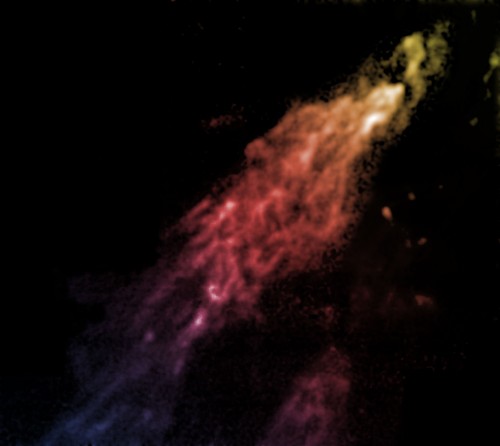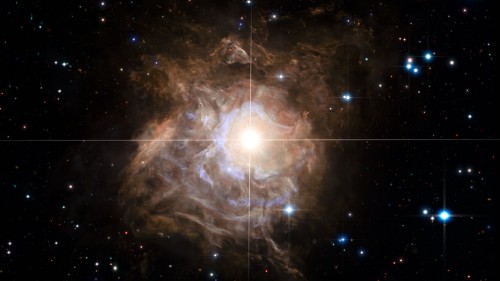Tag archives: stars
X-ray visions of the past, undead physics, stargazing cruises and more
By Tushna Commissariat
Peering into a small 17th century metallic box, without damaging its contents, is no mean feat. But thanks to the use of synchrotron radiation, scientists at the European Synchrotron Radiation Facility (ESRF) in Grenoble were able to “see” inside one, using a technique known as synchrotron X-ray phase contrast micro-tomography. They were also able to create a 3D reconstruction of clay medals concealed within the very fragile and badly oxidized box, which was discovered on the archaeological site of the Saint-Laurent church, and is now at the archaeological museum of Grenoble (MAG). Take a look at the video above to see what the box held. You can also learn more about the researcher’s tomography technique in an article of ours.
Tomorrow is Halloween, so we hope you have your physics-themed pumpkins carved and out on your doorsteps. For some spooky reading this week, take a look at Davide Castelvecchi‘s “Zombie physics: 6 baffling results that just won’t die” story over on the Nature News website. In it, he lists six “undead” results – things that physicists just can’t seem to prove or disprove – including long-running disagreements over certain dark-matter results, hemispheric inconsistencies and spinning protons. Let us know what you think are some of the most undead physics results that should be laid to rest, in the comments below. And while you are at it, make sure to look at today’s creepy edition of Fermilab Today to read about the rise of the zombie accelerator and the “The cult of the Tev.”
Coming soon(ish) to a galaxy near you

Image of Smith’s Cloud taken by the Green Bank Telescope. (Courtesy: Bill Saxton, NRAO/AUI/NSF)
By Margaret Harris at the AAAS meeting in San Jose
A giant cloud of hydrogen gas is barrelling towards the Milky Way faster than the speed of sound, and dark matter may hold it together long enough to produce a spectacular outburst of new stars in the night sky – but not for another 30 million years.
The cloud – which is known as Smith’s Cloud after Gail Bieger-Smith, who discovered it as an astronomy student in 1963 – is one of several starless blobs of hydrogen known to exist in the space between galaxies. According to Felix “Jay” Lockman, principal scientist at the US National Radio Astronomy Observatory’s Green Bank Telescope, such gas clouds are, in effect, “construction debris” left over from an earlier age of galaxy formation. “These are parts for remodelling your house that didn’t arrive by the time the contractor left,” Lockman told an audience at the 2015 AAAS meeting in San Jose, California.
Season’s greetings

A star glowing in the night. (Courtesy: ESA/Hubble)
By Hamish Johnston
Things are winding down for the holidays at Physics World and this afternoon the team will be enjoying our Christmas lunch at a local brewpub. Hopefully they will have a festive ale or two on tap! To brighten up this festive blog, we have chosen this stunning image of the variable star RS Puppis as our Christmas picture. It was taken by the Hubble Space Telescope and shows starlight reverberating through the foggy environment around the star.
View all posts by this author | View this author's profile
You spin me right round
By Tushna Commissariat
It’s not often that we come across a mention of an astronomical event measured in Earth years, let alone months or hours. So suffice to say I was pretty surprised by a recent XMM-Newton finding that talked about a star orbiting a black hole at the furious rate of once every 2.4 hours! Further investigation revealed that this has only broken the previous record by an hour, but these extremely short orbits still have me rather amazed. Certain short orbital period binary stars or pulsars do have even shorter periods of less than an hour, but this star orbits a stellar-mass black hole (it’s about three times more massive than the Sun) that is roughly a million kilometres away from it. The video below, courtesy of the European Space Agency (ESA), is an animation showing one complete orbit of the star.
View all posts by this author | View this author's profile
60 Second Adventures in Astronomy
By Hamish Johnston
If you are a fan of astronomy and the comedian David Mitchell, the Open University has a treat for you. Mitchell and the OU have made a series of 12 short animated videos about the physics of the cosmos.
View all posts by this author | View this author's profile
Astronomers discover complex organic matter abound in the universe

NASA image of the star field in the constellation Ophiucus; at the centre is the recurrent Nova RS Ophiuci (Credit: John Chumack)
By Tushna Commissariat
Complex organic compounds – one of the main markers of carbon-based life forms – have always been thought to arise from living organisms. But new research by physicists in Hong Kong, published yesterday in the journal Nature, suggests that these compounds can be synthesized in space even when no life forms are present.
Sun Kwok and Yong Zhang at the University of Hong Kong claim that a particular organic compound that is found throughout the universe contains complex compounds that resemble coal and petroleum – which have long been thought to come only from carbonaceous living matter.
The researchers say that the organic substance contains a mixture of aromatic (ring-like) and aliphatic (chain-like) complex components. They have come to this conclusion after looking at strange infrared emissions detected in stars, interstellar space and galaxies that are commonly known as unidentified infrared emissions (UIEs). These UIE signatures are thought to arise from simple organic molecules made of carbon and hydrogen atoms – polycyclic aromatic hydrocarbon (PAH) molecules – being “pumped” by far-ultraviolet photons. But Kwok and Zhang both felt that hypothesis did not fill the bill accurately enough, when they considered the observational data.
As a solution, they have suggested an alternative – that the substances generating these infrared emissions have chemical structures that are much more complex. After analysing the spectra of star dust forming when stars explode, they found that stars are capable of making these complex organic compounds on extremely short timescales of weeks and that they then eject it into the general interstellar space – the region between stars.
Kwok had suggested, at an earlier date, that old stars could be “molecular factories” capable of producing organic compounds. “Our work has shown that stars have no problem making complex organic compounds under near-vacuum conditions,” says Kwok. “Theoretically, this is impossible, but observationally we can see it happening.”
Another interesting fact is that the organic star dust that Kwok and Zhang studied has a remarkable structural similarity to complex organic compounds found in meteorites. As meteorites are remnants of the early solar system, the findings raise the possibility that stars enriched our protoplanetary disc with organic compounds (by angela). The early Earth was known to have been bombarded by many comets and asteroids carrying organic star dust. Whether these organic compounds played any role in the development of life on Earth remains a mystery.
It will also be interesting to see if this finding has an impact on research groups that look for life in the universe, such as SETI , considering that complex organic molecules have always thought to be markers of carbon-based life forms.
View all posts by this author | View this author's profile
Starry Starry Night
By Tushna Commissariat
It is commonly thought that astronomy and astrophotography are rather exclusive hobbies and that you require a lot of specialist equipment and training to pursue them. But an amateur astrophotographer, using only his ordinary digital SLR camera, a tripod and his love for the skies, has won the major astrophotography prize at the inaugural STARMUS festival.
Not only did Alex Cherney win the opportunity to attend and mingle with the who’s who of astronomy at the STARMUS festival – an astronomy and space-science festival held in the Canary Islands this June – but the Australian amateur astronomer also won an hour using one of the largest optical telescope on the planet – the 10.4 m Gran Telescopio Canarias (GranTeCan), in the Canary Islands in Spain.
Cherney’s prize-winning collection of time-lapse sequences of the Milky Way, seen over the Southern Ocean, beat a bevy of global participants for the best entry as judges felt his scenes were “chosen with the eye of an artist” and that his “subtle panning and excellent control of colour and contrast revealed technical skills of the highest order”. Cherney uses only his Nikon D700 DSLR camera and produced a compilation of images taken over 31 hours of exposure time.
This is notably the first time an amateur astronomer has been allowed access to the GranTeCan and Cherney was keen to make the most of the opportunity. After much deliberation, he decided to use his hour to observe and photograph Arp84, a pair of interacting galaxies – NGC5394 and NGC5395. (Image above courtesy: Alex Cherney)
“I wanted an object that would look nice given the parameters of the telescope and has not been photographed in colour and great detail by a professional telescope,” he said. Noel Carboni, an astro-image-processing expert, met Cherney at the festival and helped to produce a colour image. Carboni feels this is the clearest image of Arp84 ever made. Cherney felt the experience of using the telescope was “incredible”, akin to taking a space flight. “It is very hard to describe what it is like to observe space with an instrument that is helping scientists seek answers to the origin of the universe.”
Cherney put his opportunity of being at the La Palma observatory to good use, producing another time-lapse video featuring GranTeCan and MAGIC (Major Atmospheric Gamma-ray Imaging Cherenkov Telescopes) as the backdrop for the night skies. Take a look at the stunning video below.
Outer Space from Alex Cherney on Vimeo.
View all posts by this author | View this author's profile
